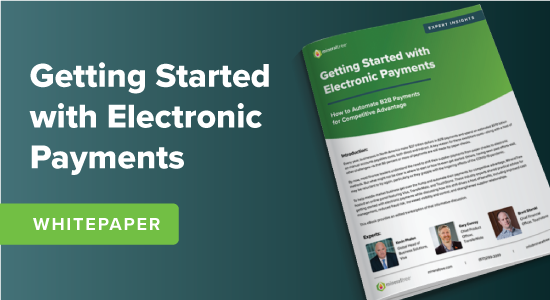There’s no doubt that AP and payment automation solutions offer tremendous benefits. They give enterprises visibility into their payments and supplier relationships, while providing much-needed cost savings and efficiencies to understaffed and overworked Accounts Payable (AP) departments. So, the question for many becomes not whether to work with a provider to digitize their AP workflow and payments, but rather, how to choose a provider that is right for them.
One major consideration that most enterprises have when automating and optimizing their payments is Return on Investment (ROI). The challenge, however, is that providers often don’t offer the same capabilities or services, so it can be difficult to make an apples-to-apples comparison.
Take card rates, for instance. Providers might offer a different cash back percentage on supplier payments using credit or virtual cards. While it’s easy to focus on that number and look for the provider offering the highest rate, that doesn’t mean that you will get the largest rebate or cash back for your organization. There are a lot of other factors that go into determining the full value of the solution.
The highest rate doesn’t always result in the highest earnings
Here are six questions to ask potential AP and payment providers to make sure you are capturing the largest earnings from your digital payments – and gaining the greatest value:
1. Do we have to spend a certain amount before we receive rebates?
Some providers require that you reach a minimum threshold before you can collect rebates. Depending on this threshold and the amount of your payables, you might earn more money by collecting rebates on all your spend, rather than getting a higher rate on some of it.
2. How do you onboard suppliers?
Supply chain issues during the pandemic underscored just how important your suppliers are. You should look for a provider who treats your suppliers with respect, the same way you do. Avoid providers who put pressure on providers to accept a specific payment method. Ultimately, any card spend gained through these aggressive tactics could be offset if relationships with strategic suppliers are strained or damaged.
3. Do you offer ongoing enablement services?
The more suppliers that sign on for virtual cards, the greater the rebates you will earn. Find out if your provider offers an ongoing enablement program that will allow you to add more suppliers, and increase your rebates. This is particularly important for a growing company that is continually expanding its supplier base.
4. What services do you provide to providers?
Just as the customer experience is paramount, so too is the supplier experience. It’s critical to your company’s growth and success, enabling you to gain access to a steady stream of goods and services. With that in mind, ask about the services that your suppliers will receive. Is there a vendor portal where they can have full visibility into their payments not only from your company, but from all their buyers on the platform? Does the provider offer a full managed service along with a dedicated team that will provide fast responses to any supplier inquiries? Does it offer suppliers choice over the payment method? Is it easy for them to enroll, or change their payment details and method?
5. What type of security do you offer?
With 81% of companies experiencing attempted or actual payment fraud, according to the 2020 AFP Payments Fraud and Control Survey Report, financial security is more important than ever. Ensure that the provider is using the latest security functionality to keep your financial data and your suppliers’ data safe. Look for capabilities such as two-factor authentication, segregation of duties, and multi-tiered approvals. Virtual cards take security even further by providing added protection. While these cards are processed in the same manner as other credit cards, they offer heightened security through randomized account numbers that are authorized for one-time use only, and for a specific amount.
6. Does the provider offer full invoice to payment automation?
Imagine that in addition to the visibility, efficiencies, and cost savings that electronic payments offer, you could benefit from that on the front-end too, in the time-consuming invoice management process. By using a provider that offers full invoice to payment automation, you will multiply your benefits while creating enhanced visibility, security, and real-time analytics for audit trail across your end-to-end AP process.
It’s all about value
When it comes down to it, it’s all about value. Consider which provider allows you to achieve the greatest efficiency, security, and visibility for your enterprise as well as for your suppliers. Who will best help strengthen supplier relationships by expediting payments through efficient processes, and treating them the way they want to be treated?
These benefits are invaluable to your enterprise, and as it turns out, if the provider offers continuous onboarding and factors in all your spend, without requiring threshold minimums, you might just be earning more money anyway. Either way, you win by helping your AP department achieve stability, security, and optimized operations.





